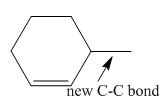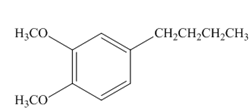
(a)
Interpretation: Product of the given coupling reaction is to be predicted.
Concept introduction: Organocuprate reagents
Answer to Problem 26.1P
The product of the given coupling reaction is octane as shown below.

Explanation of Solution
Species containing copper-carbon bonds are known as organocuprate reagents. These reagents act as nucleophille and react with organic halides to form coupling products that contains new

Figure 1
Product formed from the coupling reaction is shown in Figure 1.
(b)
Interpretation: Product of the coupling reaction is to be predicted.
Concept introduction: Organocuprate reagents
Only one alkyl group of the organocuprate reagent is transferred to form the product, while the other becomes part of reaction’s by-product.
Answer to Problem 26.1P
The product of the coupling reaction is

Explanation of Solution
Species containing copper-carbon bonds are known as organocuprate reagents. These reagents act as nucleophille and react with organic halides to form coupling products that contains new

Figure 2
Product formed from the coupling reaction is shown in Figure 2.
(c)
Interpretation: Product of the coupling reaction is to be predicted.
Concept introduction: Organocuprate reagents
Only one alkyl group of the organocuprate reagent is transferred to form the product, while the other becomes part of reaction’s by-product.
Answer to Problem 26.1P
The product of the coupling reaction is

Explanation of Solution
Species containing copper-carbon bonds are known as organocuprate reagents. These reagents acting as nucleophille and react with organic halides to form coupling products that contains new

Figure 3
Product formed from the coupling reaction is shown in Figure 3.
(d)
Interpretation: Product of the coupling reaction is to be predicted.
Concept introduction: Organocuprate reagents
Only one alkyl group of the organocuprate reagent is transferred to form the product, while the other becomes part of reaction’s by-product.
Answer to Problem 26.1P
The product of the coupling reaction is

Explanation of Solution
Species containing copper-carbon bonds are known as organocuprate reagents. These reagents act as nucleophille and react with organic halides to form coupling products that contains new

Figure 4
Product formed from the coupling reaction is shown in Figure 4.
Want to see more full solutions like this?
Chapter 26 Solutions
ORGANIC CHEMISTRY
- V Biological Macromolecules Drawing the Haworth projection of an aldose from its Fischer projection Draw a Haworth projection of a common cyclic form of this monosaccharide: H C=O HO H HO H H OH CH₂OH Explanation Check Click and drag to start drawing a structure. Xarrow_forwardComplete the mechanismarrow_forwardComplete the mechanismarrow_forward
- 8 00 6 = 10 10 Decide whether each of the molecules in the table below is stable, in the exact form in which it is drawn, at pH = 11. If you decide at least one molecule is not stable, then redraw one of the unstable molecules in its stable form below the table. (If more than unstable, you can pick any of them to redraw.) Check OH stable HO stable Ounstable unstable O OH stable unstable OH 80 F6 F5 stable Ounstable X Save For Later Sub 2025 McGraw Hill LLC. All Rights Reserved. Terms of Use | Privacy C ཀྭ་ A F7 매 F8 F9 4 F10arrow_forwardJust try completing it and it should be straightforward according to the professor and TAs.arrow_forwardThe grading is not on correctness, so if you can just get to the correct answers without perfectionism that would be great. They care about the steps and reasoning and that you did something. I asked for an extension, but was denied the extension.arrow_forward
 Organic ChemistryChemistryISBN:9781305580350Author:William H. Brown, Brent L. Iverson, Eric Anslyn, Christopher S. FootePublisher:Cengage Learning
Organic ChemistryChemistryISBN:9781305580350Author:William H. Brown, Brent L. Iverson, Eric Anslyn, Christopher S. FootePublisher:Cengage Learning Chemistry for Today: General, Organic, and Bioche...ChemistryISBN:9781305960060Author:Spencer L. Seager, Michael R. Slabaugh, Maren S. HansenPublisher:Cengage Learning
Chemistry for Today: General, Organic, and Bioche...ChemistryISBN:9781305960060Author:Spencer L. Seager, Michael R. Slabaugh, Maren S. HansenPublisher:Cengage Learning Organic Chemistry: A Guided InquiryChemistryISBN:9780618974122Author:Andrei StraumanisPublisher:Cengage Learning
Organic Chemistry: A Guided InquiryChemistryISBN:9780618974122Author:Andrei StraumanisPublisher:Cengage Learning



